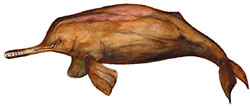 The prime ministers, presidents and kings gathering at Dhaka this weekend must learn a bit from the region's dolphins: the fresh water kind.
The prime ministers, presidents and kings gathering at Dhaka this weekend must learn a bit from the region's dolphins: the fresh water kind. Dolphins are mammals and not fish and a geological and morphological phenomenon
 relating to freshwater dolphins might actually teach us something about conducting ourselves as humans.
relating to freshwater dolphins might actually teach us something about conducting ourselves as humans. The Gangetic Dolphin is called the susu and the Indus Dolphin is called the bhulan. Once abundant enough in these rivers to be included in environmental edicts promulgated by Emperor Ashok (he called them puputaka), today dolphins are gravely endangered species of our Southasian waters.
In India, the best place to see them today is from a boat off Patna at the point where the Gandak comes in from the north to meet the Ganga. Here, the creatures frolic. But elsewhere on both basins their habitat has been destroyed by barrages, canals, PCBs and DDT. Today, there are said to be no more than 2,000 of the susu on the Ganga-Brahmaputra (extending up to Nepal and as far downstream as Bangladesh) and 500 on the Indus (all within Pakistan).
The grey-brown mammals average two metres in length as adults, have evolved blind due to the natural turbidity of the Southasian rivers, and prefer to swim on their sides, with their lower fins possibly used to trawl the muddy river bottoms. The specie(s) use sonar to travel and to track prey (small fish and prawns).
Till the 1970s, these two pointed snout creatures had been considered the same species, though inhabiting different river basins, one emptying into the Bay of Bengal and the other the Arabian Sea (thus the two species are today separated by thousands of kilometres). The world's other two species of freshwater dolphins are found in the Yangtse and Amazon.
After the 1970s, the distinction between the two species, primarily in the shape of the skull, made scientists separate them into two sub-species know as Plantanista gangetica and Plantanista minor. Since the late 1990s, once again scientific opinion is drifting towards regarding them as one and the same species of the genus cetacean.
So here we have a species that clearly evolved in the one and the same Tethys Sea, somewhat before geological forces created the Himalaya-Hindukush, and even as the silting created the Indus and Ganga plains and the rivers which began to flow on them. In this fresh water evolved the Southasian dolphin, which represents together with whales and porpoises the mammals that decided to return to water (rather than the fish which had always remained there).
At some point, there must have been a geological cataclysm which separated the water courses of Southasia, so that the Ganga flowed southeast-ward and the Indus went south-westward. This might have been the moment when the two species got separated by habitat, which isolation helped them evolve separately.
But it has not been such a long separation that they have diverged in any noticeable way. If the two species were to be put on the same muddy river course on either side of the Line of Control, they would probably say hello as they passed each other in the murk.
We, thus, have species of creation divided by geological time and yet we are confused about what to call them. Are they the same species? Are they separate species? The answer is that they are both! Together, these two dolphin species make up the Southasian Freshwater Dolphin. And separately they are the susu and the bhulan.
The same should hold true for the people within the different nationalities of Southasia. Rather than regard our identities more rigid and separate, we must try to consider ourselves as having multiple identities. The fact is that the Westphalian tradition did not prepare us for this concept of grey zones where identities meet, whereas our past did cater to this uniqueness of Southasia. Only the acceptance of multiple identities is feasible for the multi-layered demography that makes us proud to be Southasians. Let us learn from the dolphins, even at the SAARC Summit.



